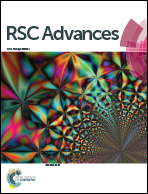Enhancing photovoltaics with broadband high-transparency glass using porosity-tuned multilayer silica nanoparticle anti-reflective coatings
Abstract
The performance of optoelectronic devices using glass envelopes can be improved substantially by the application of an effective anti-reflective coating. In this paper, we investigate the preparation of low index films through modulation of the porosity of silica nanoparticle films. Porosity variation is accomplished by introducing polystyrene porogen within colloidal silica nanoparticle films, which are deposited in a controlled manner, followed by pyrolysis of the porogen. Multilayer stacks of nanoparticle films with varying degrees of porosity were fabricated by sequentially spin coating and sintering various silica–polystyrene mixtures. The average transmittance (400–1000 nm) of Corning glass was improved from 91.0% to 95.2% using a three layer stack on one glass–air interface, and to 99.0% using three layer stacks on both interfaces – the highest reported values for facile synthesized multilayer structures. Utilization of the single and dual interface high transparency glass placed on a crystalline silicon solar cell leads to increased photocurrent densities by 4.0% and 6.0%, respectively, relative to uncoated glass.


 Please wait while we load your content...
Please wait while we load your content...